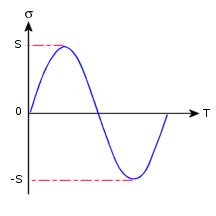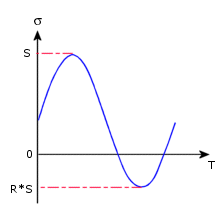 |
No. of Cycles |
Specifies the number of cycles associated with this event. |
 |
Loading Type |
Specifies the type of fatigue loading to determine the stress peaks and the
alternating stress. Alternating stress = |maximum stress -
minimum stress|/2, where | | denotes the absolute value.
|
Fully reversed (LR = -1)
|
The fatigue event is based on one reference study. All the loads, and the stress
components, in the reference study reverse their
directions simultaneously for the specified number of
cycles in the event.

|
|
Zero-based (LR = 0).
|
The fatigue event is based on one reference study. All the loads, and the stress
components, in the reference study change their
magnitudes proportionally from their maximum values as
specified by the reference study to zero.
|
|
Loading ratio
|
The fatigue event is based on one reference study. Each load, and each stress
component, in the reference study changes its magnitude
proportionally from its maximum value (Smax) to a minimum value
defined by R*Smax, where R is
the load ratio. A negative ratio indicates reversal of
the load direction.
- Loading ratio
 . Enter a
loading ratio. . Enter a
loading ratio. Fatigue loads
are proportional when the directions of principal
stresses for each node are identical for all the
reference studies that you use in defining fatigue
events. In all other cases, the fatigue loads are
nonproportional.

|
|
Find Cycle Peaks
|
The fatigue event is based on several load cases. The program calculates the
alternating stresses for each node by considering the
combination of peaks from different fatigue loads. Then,
it determines the combination of loads that produces the
largest stress fluctuation. The
fatigue loads can refer to one or more static
studies, or to a particular solution step of a
nonlinear or linear dynamic time history
study.
|
|
 |
Study Association |
Specifies the reference studies.
|
No.
|
Study counter. Select
Find cycle peaks to
continue defining up to 40 load cases. Double-click
in the No. cell to add a row.
All studies must have the same mesh.
|
|
Study.
|
Specifies the reference study. Click in
this cell to select a study from the list menu. For a
reference study, you can select a static study, or
stress results from a particular solution step of a
nonlinear or linear dynamic time history study. The list of studies includes the
studies that are associated with the active
configuration only.
|
|
Scale.
|
Defines a fatigue event based on a
reference study with scaled loads. Since the study
is linear, the program uses this factor to scale the
stresses. You cannot scale loads defined in a
nonlinear study.
For example, the reference study has
a pressure load of 50 psi applied to a face. To
define a fatigue load based on 150 psi on the same
face, enter a scale factor of 150/50 = 3. The
program multiplies the stress results of the
reference study by this factor to calculate stress
values for use in calculating alternating
stresses.
|
|
Step.
|
Defines the solution step for the
reference nonlinear or linear dynamic study. The program
uses the stress results of this particular step to
calculate the alternating stresses.
|
You can use the same study for defining
multiple fatigue events.
|